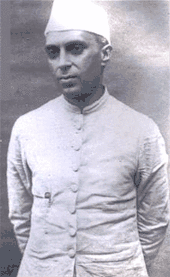Mandarin collar
A mandarin collar, standing collar, band collar or choker collar is a short unfolded stand-up collar style on a shirt or jacket. The style derives its Western name from the mandarin bureaucrats in Qing-era China that employed it as part of their uniform.

The length along a mandarin collar is straight, with either straight or rounded edges at top of the centre front. The edges of the collar either barely meet at the centre front or overlap slightly.[1] Overlapping mandarin collars are often a continuation of a shirt's placket and have a button on the collar to secure the two sides of the shirt together.
Related nomenclature

A similar style known as the Nehru collar is also found in some modern Indian men's clothing, such as the Nehru jacket. (Named for Jawaharlal Nehru, Prime Minister of India 1947–1964, who commonly wore clothing with this type of collar.)
A band is often a mandarin collar. This term is also used for shirts that have only a flat finishing around the neckline; originally such garments were designed for use with a detachable collar, a largely forgotten usage.
Usage
In contemporary Western dress, mandarin collars are found in Asian-style and minimalist clothing. Women's mandarin-collared jackets often include other vaguely Asian elements, such as silk knots as closures instead of buttons.
Since mandarin collars are short and do not fold over, neckties are not worn with mandarin-collared dress shirts. This lack of ties may have led to the recent rising popularity of mandarin collars.[2]

Mandarin collars are also heavily utilized in modern-day military combat uniforms such as the US Army's Army Combat Uniform. The presence of the mandarin collar on the ACU makes the wearing of body armor more comfortable by lifting the collar up to prevent chafing. Standing collars are also common on historically based military dress uniforms, such as dress uniforms of the British Army, US Navy and US Marine Corps. Even the Russian Army uses a mandarin collar in their newer VKBO uniforms
Mandarin collars are also the proper shape for a single-breasted Greek cassock, or anterri, for Eastern Orthodox and Eastern Catholic clergy. Russians and other Slavic Churches typically have a high, band-style collar, buttoning to the side or on the shoulder, while Greeks have the "notched" Mandarin pattern with a closing loop or hook at the bottom of the "V" in the collar.
The collar is also used for the required sport fencing dress.
Mandarin collars feature in costumes in some notable films, where they are employed either as a futuristic style fashion or to create a distinctive appearance for sinister characters. The title character in the 1962 James Bond film Dr. No, as well as Bond's nemesis, Ernst Stavro Blofeld, both parodied by Doctor Evil in the Austin Powers series of films are depicted wearing mandarin collared shirts. The mandarin collar can also be found in the uniform of the Empire's officers in the Star Wars films. Mandarin collar lab coats and a jacket also feature in the CBBC show The Demon Headmaster (TV series) when the antagonist known as 'The Demon Headmaster' takes on the roles of 'Computer Director' (Series 1 Episodes 4-6), 'Director of the Biogenetic Research Centre' (BRC) (Series 2) and the 'Controller' (Series 3)
See also
- Changshan, magua, & tangzhuang
References
| Wikimedia Commons has media related to Mandarin collars. |
- "What is a Mandarin collar?". MANDO Clothing.
- Cut Ties: Join The Mandarin Collar Society